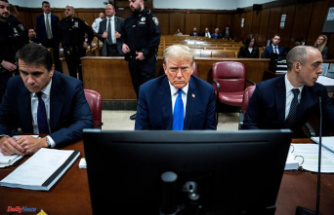The steering wheel moves as if by magic. The car follows the vehicle in front as if by itself and keeps the correct distance. But neither Harry Potter nor other magicians are at work, but a number of assistance systems that depend on help. They receive their information from sensors that precisely measure their surroundings.
In the new Mercedes-Benz S-Class with the Drive Pilot assistant, which, as a traffic jam assistant, enables the car to drive at up to 60 km/h on freeways alone, a number of different types of sensors are used. "The car only takes control when the external conditions are met," says Gregor Kugelmann, who heads the development of driver assistance systems at Mercedes-Benz.
One of these sensory helpers is the stereo camera. It comes closest to the human eye, says Prof. Christoph Stiller from the Institute for Measurement and Control Engineering at the Karlsruhe Institute of Technology (KIT). For an all-round view, however, vehicles need more than just two lenses.
But then they essentially see what humans see. These include lane markings, traffic light colors and information signs. Disadvantage: A stereo camera does not see very far, a maximum of 80 meters - not much when driving fast.
When it comes to long-distance vision, radar systems are better – but according to Christoph Stiller, they do not recognize traffic light colors, street signs or lane markings. Corresponding technology has been installed in vehicles since the year 2000, for example for distance cruise control.
In contrast to the camera, the radar system works actively by emitting and recapturing microwaves. This distance measurement based on the echo principle also works in the dark and up to 300 meters away. The technology makes use of the so-called Doppler effect.
"Radar is excellent at measuring speeds and is ideal for detecting moving objects," says Prof. Markus Lienkamp from the Chair of Vehicle Technology at the Technical University of Munich (TMU).
The way lidar sensors work seems almost futuristic. In contrast to radar, such systems do not emit microwaves, but bundled laser beams. This allows a lidar to scan individual points in the area. It measures the time between sending and receiving and uses this to calculate the distance.
Lidar systems compose an image with around one million pixels per second from many such reflections. This creates a 3D point cloud that represents the environment with a higher resolution than a radar image. This enables it to depict complex objects and, for example, distinguish a pedestrian from a car.
A lidar only recognizes road markings to a limited extent based on the reflections, traffic light colors not at all. "A major advantage lies in the early detection of pedestrians, who, in contrast to cars or cyclists, offer little metal for reflection, as radar requires," says Prof. Stiller.
Each type of sensor therefore offers advantages and disadvantages. But if you combine them, they make automatic driving functions possible.
"From a purely technical point of view, a stereo camera or a lidar would also be sufficient for automated driving," says Christoph Stiller. But this would be less reliable and safe. In addition, car manufacturers rely on high-resolution digital maps that contain the position of the edges of the road, for example, with an accuracy of around five centimetres.
Incidentally, ultrasound only plays a subordinate role in the sensors of automated driving, since it can only detect an area of around ten meters. Appropriate systems are used for parking aids, for example.
Radar and lidar can determine distances precisely, humans can only estimate them. On the other hand, people can better assess situations based on their experience. He recognizes patterns and understands scenes and can react to them. "No computer can solve this complex behavior yet," says Markus Lienkamp.
For example, manufacturers of automated vehicles use different technologies that work redundantly. According to the motto: twice as much is better.
The Mercedes has a lidar for the 3D environment display in the front, as well as a radar for measuring distance and speed. A stereo camera in the windscreen provides optical image capture. A camera in the cockpit recognizes the attention of the person at the wheel - he is not allowed to sleep.
A sensor in the wheel housing listens for heavy rain on the road, and the driver has to take over in the event of heavy rain. And on the roof is a sensitive antenna that relays the exact position, which is compared to high-resolution maps.
For the close range, ultrasonic sensors detect whether someone is near the car, such as children playing. A camera in the rear window and microphones recognize blue lights and emergency vehicles - and in an emergency ensure that the car moves to the side for an emergency exit.
Since December 2021, Mercedes-Benz has been the first manufacturer to have been approved by the Federal Motor Transport Authority (KBA) for the new function, which corresponds to Level 3 in the five-stage classification of automated driving functions. The manufacturer offers them as an option in the S-Class for a surcharge of 5950 euros. The feature is also available for the EQS electric sedan.
In the next ten years, all vehicles with a Level 3 function for "highly automated driving" will rely on a combination of the various sensors. "After the luxury class vehicles, the technology will also find its way into other classes because it is becoming cheaper," says Stiller.
Lienkamp also assumes that all automated vehicles will be equipped with full sensor technology in the future. In Level 4 vehicles for "fully automated driving", the sensors hardly change, but the algorithms and the software of the systems that can permanently take over the wheel on motorways do. This means that the steering wheels will work even more precisely in the future and follow the traffic more closely.
"Everything on shares" is the daily stock exchange shot from the WELT business editorial team. Every morning from 7 a.m. with the financial journalists from WELT. For stock market experts and beginners. Subscribe to the podcast on Spotify, Apple Podcast, Amazon Music and Deezer. Or directly via RSS feed.












